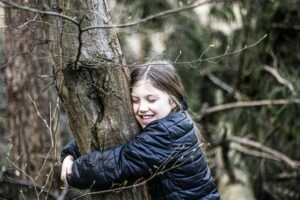After a long winter of being cooped up indoors, it’s time to get outside and start exploring. Spring is the perfect time to get outside with your students and start experiencing the joy and wonder of outdoor learning. As the winter changes to spring, our world is bursting with new life. So why not use it as a chance to breathe new life into your teaching
Outdoor learning has so many benefits for both our students and ourselves as teachers. Nature truly nurtures the whole child (and teacher) and provides opportunities for physical, mental, social/emotional, and even spiritual growth. However, in addition to this, you can also create opportunities for rich and meaningful curriculum-based learning for your students.

Why Spring is the Perfect Time for Outdoor Learning
Students are itching to get outside and you might be experiencing a bit of cabin fever from being indoors all winter. The temperature is warmer (but not too hot yet) and the daylight hours are longer. For most people, it is simply more comfortable to be outside now. Spring offers the perfect opportunity to reinvigorate your class and start getting into nature.
Additionally, nature is coming to life and putting on a show. It is the perfect time to practice skills such as observation, asking questions, or simply just exploring the changes that are occurring in your outdoor learning space. The new life also sparks creativity and provides invitations for creative expression in art or writing. No matter what subject you teach, with a little creativity you can take learning outside.
Preparing for Outdoor Learning
If you are new to outdoor learning, take some time to prepare yourself and your students for getting outside. This is important for both the safety of our students as well as for both their and our own enjoyment of the time outdoors. From my experience, here are some of the basics for getting ready for outdoor lessons.
Setting Expectations: Before you head outside, take some time to establish the expectations for your outdoor learning time. You will need to set expectations for
- Where students are allowed to be/not be
- What are they expected to do while outside
- Looking after equipment and materials
- What to do in an emergency
Gathering Supplies: Have what you need ready to go ahead of time. We have a wagon that is ready to go with clipboards, magnifying glasses, nature journals, and art materials. (I find most of our materials like clipboards and magnifying glasses at the dollar store.) I also have a backpack with safety equipment and teaching supplies. Students are responsible for their own clothing and water bottles
Scouting Locations: Outdoor learning doesn’t mean that you need to wander into a forest or have access to a nature preserve. Nearby nature is all around us. You can use your schoolyard, nearby parks, or even trees near your school. If you are venturing away from your school, be sure to do a site assessment ahead of time to ensure that the space is safe for your students to use.
Safety Considerations: Before you take your students outside, there are a few things that you will need to be aware of.
- Check your site ahead of time. Are there any safety concerns that you need to address or make your students aware of?
- Do your students understand where the boundaries are? Do you need to mark them? (Clearly marking boundaries is especially important for younger students who have a tendency to wander more.)
- Are there any allergies or special needs in your class that you and other adults will need to be aware of?
- Do you have a first aid kit, working cellphone, and whistle?
- Do you have a way to gather students in the case of an emergency?
Prepare Students/Families: Let families know well in advance that you will be spending time outdoors. Help families prepare their students to be comfortable outdoors by communicating what students will need for clothing or equipment. I like to give examples with pictures (usually of what my own kid wears/uses) so that families who are new to the country/area know what to look for. Have some extras just in case families forget or are unable to provide these items.
Easy Outdoor Learning Activities for Spring
Now that you have spent some time preparing, it’s time to get outside. Here are some easy outdoor learning activities to help you get started. Many of these activities can be easily adjusted to match your curriculum and grade level.
Science & Nature Exploration:
- Observe and document signs of spring (budding trees, insects, bird migration).
- Older students may use tracking apps or participate in biodiversity assessments.
- Plant a small garden or track plant growth.
- Conduct simple weather experiments (measuring rainfall, wind direction).
- You can even make your own weather instruments.
Math in Nature:
- Count and graph natural objects (leaves, flowers, insects).
- Older students can track species diversity and graph populations.
- Measure tree heights using simple tools.
- Estimating tree height is also fun!
- Create patterns with natural materials (rocks, petals, sticks).
Literacy and Writing Outdoors:
- Write nature-inspired poetry or stories.
- Practice descriptive writing using sensory observations.
- Read books about nature in an outdoor reading nook or under a tree.
Art and Creativity:
- Leaf rubbings, nature collages, or watercolor painting outside.
- Building structures with sticks and natural materials.
- Creating outdoor music with found objects (drumming on logs, wind chimes).
Overcoming Common Challenges
Even the best-laid plans can experience setbacks sometimes. Don’t let these challenges stop you from getting outside. Simply make a plan and learn from these common setbacks.
“I Don’t Have Enough Time!”
This is one that I hear (and sometimes even use myself) a lot. There is simply not enough time in a school day to do everything. However, take heart in knowing that outdoor learning time does not need to be long. Simply start with 10-15 minute lessons/activities and build from there. A great way to help avoid extra transitions is to build the outdoor learning time onto recess. Go out 15 minutes early or stay 15 minutes after recess.
Another way to help build in time for outdoor learning is to take one of your subjects outside. Start with one subject or a familiar activity, such as reading or journaling. Since students are familiar with this activity already, you can eliminate some of the time required to explain or discuss the activity.
“My Students Won’t Stay Focused!”
This one is a huge challenge, especially for teachers who are new to outdoor learning. I too have experienced this many times. A carefully laid out lesson turns into chaos because students become distracted by something (like a garbage truck driving by.)
One thing that I have found that works great in keeping students on task is to have clear, simple activities with a structured task and a time limit. This way students know exactly what is expected of them and how much time they have. Once the time is up we come back together and they have to share their progress. They then move on to the next task or move on to some free exploration time.
Once students are comfortable with the flow and understand the expectations of your time outdoors, they are more capable of handling unstructured activities. It takes some time, but the rewards are amazing.
“Weather is Unpredictable!”
Yes it is! Where I live they say, “If you don’t like the weather, just wait 10 minutes and it will change…” (actually I think they say that everywhere!) This one is an easy one. Have a backup plan. I’m a firm believer that if I plan a backup plan, I won’t need to use it….It’s when I don’t have a backup plan that I usually need it. Your backup plan may simply be moving to different location (for example a more sheltered space if it is raining) or an indoor version of your lesson. No, you don’t need to have 2 separate lesson plans for everything that you do. You just need to be flexible and be able to roll with the weather. (Of course please don’t go outside if the conditions are dangerous.)
Encouraging a Culture of Outdoor Learning
Once you start experiencing the many benefits of outdoor learning, you are going to want to get everyone on board. Start spreading the news and encouraging a culture of outdoor learning. Get your administration, other staff members and families on board by sharing the benefits of outdoor learning. Show your school community the cool things you and your class are doing outside. Bonus points if you can show how you are covering your curriculum while your students are outdoors having so much fun.
Make outdoor learning a part of your routine. I have heard of some schools that make outdoor learning a half-day weekly event (ie, “Wild Wednesdays.) Our class makes it a daily part of our schedule. By making it a regular occurrence you signal to your class and the community that this is important and we are fully embracing it.

Now Let’s Get Outside and Embrace Outdoor Learning
Spring brings new life to the world and it can also bring new life to your teaching. Get outside with your students and help them to experience the holistic benefits of outdoor learning. Both you and your students will love the break from being indoors and will love being able to experience the world in a new way.
Outdoor learning doesn’t need to be complicated or challenging. You don’t even need to be “outdoorsy” to get outside with your students. Start small and take the opportunity to explore what nature has to offer. It will revitalize both you and your students.
Images from: Murat IŞIK from Pexels. and Lamar Belina from Pexels.
About Shannon McLeod
Shannon is a regular classroom teacher who discovered the joy and excitement of outdoor learning early in her career. She has a passion for helping other teachers, even those who don’t consider themselves to be “outdoorsy,” take learning outside.
Over the past 15 years, Shannon has taught everything from kindergarten to 8th grade in a rural school setting. In each of her teaching positions, Shannon has found ways to adapt the curriculum for outdoor learning. Through taking her students outside on a regular basis, Shannon has seen both the amazing holistic health benefits as well as the academic benefits of outdoor learning in her students.
When she is not teaching, Shannon enjoys spending time with her husband, daughter, and their rescue dog, Vance. They enjoy hiking, canoeing, skiing, and going on adventures together.


